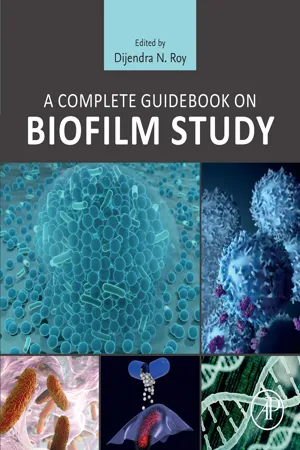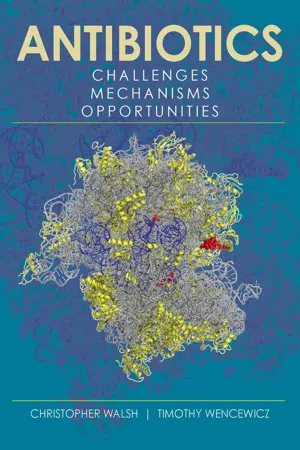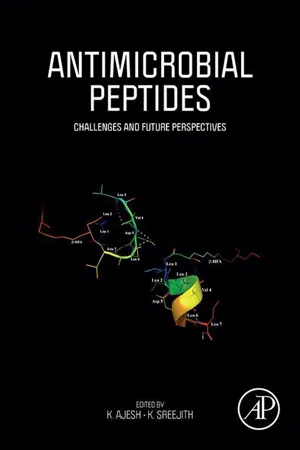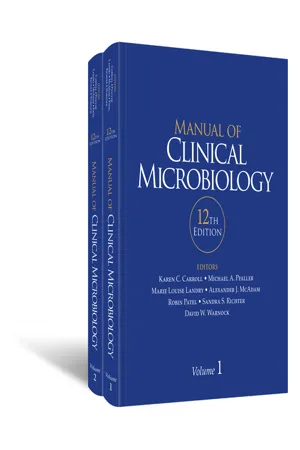Biological Sciences
ESKAPE Pathogens
ESKAPE pathogens are a group of bacteria that are responsible for the majority of hospital-acquired infections. The acronym stands for Enterococcus faecium, Staphylococcus aureus, Klebsiella pneumoniae, Acinetobacter baumannii, Pseudomonas aeruginosa, and Enterobacter species. These pathogens are known for their ability to resist multiple antibiotics, making them difficult to treat.
Written by Perlego with AI-assistance
Related key terms
Related key terms
1 of 4
Related key terms
1 of 3
5 Key excerpts on "ESKAPE Pathogens"
- eBook - ePub
- Dijendra N. Roy(Author)
- 2022(Publication Date)
- Academic Press(Publisher)
[76] . As the option of antibiotics is getting smaller along with only slow changes in prescribing actions, we are moving towards a postantibiotic age.The term ‘ESKAPE' is a word played for six bacterial pathogens linked with multidrug resistance. Enterococcus faecium (E. faecium), Staphylococcus aureus (S. aureus), Klebsiella pneumoniae (K. pneumoniae), Acinetobacter baumannii (A. baumannii), P. aeruginosa, and Enterobacter spp. [109] ). Of the six popular ESKAPE Pathogens, four Gram-negative bacteria, i.e., K. Pneumoniae, A. baumannii, P. aeruginosa , and Enterobacter spp. have been associated with four major forms of multidrug resistance (MDR), including extended-spectrum β-lactamase (ESBL)-producing K. Pneumoniae and Enterobacter spp., carbapenemase-producing A. baumannii and metallo-β-lactamase P. aeruginosa (MBL-PA) which restrict therapeutic options and negatively affect treatment benefit [142] .A considerable level of fatal nosocomial infections is caused by ESKAPE Pathogens. These pathogens are also capable of “escaping” the biocidal action of an antimicrobial drug that has recently gained global consideration [7 ,122 ]. MDR is typically associated with substantially higher morbidity, mortality, disease prolongation and decreased labor efficiency [65 ,113 ]. Recently, new drug targets have been recognized such as virulence and pathogenicity, tolerance against these pathogens has led to the development of new antimicrobial strategies [187] .4.3 Major issues linked to antimicrobial resistance in ESKAPE Pathogens
ESKAPE-induced infections lead to high mortality and morbidity rates, increased healthcare costs, treatment dilemma, and difficulty in initiating empirical treatment [142] . In 2017, Member States requested the World Health Organization to develop a Global Priority Pathogen List (PPL) of antibiotic-resistant bacteria in order to prioritize research and make new and effective antibiotic therapy (Shweta [157] ). The stratification divides the pathogens into critical, high, and medium priorities. Carbapenem-resistant A. baumannii, P. aeruginosa , and Enterobacteriaceae species, including K. pneumonia , are listed in the critical priority list. E. faecium (VRE), Methicillin‐resistant and vancomycin‐intermediate/resistant S. aureus (MRSA or VRSA), are listed as pathogens of high priority. ESKAPE Pathogens are associated with a high risk of mortality and growing financial costs [65] . The US Centers for Disease Control and Prevention (CDC) estimates that antibiotic-resistant microorganisms cause more than two million infections in the United States each year, resulting in at least 23,000 deaths [170] . The total estimated cost of fighting resistance to five pathogens (S. aureus, E. coli, K. pneumoniae, A. baumanii, and P. aeruginosa ) in Thailand and the United States was $0.5 billion and $2.9 billion, respectively [149] . Despite the frequency in which ESKAPE species are encountered in the clinical environment, it is not surprising that several different AMR mechanisms are found in these pathogens. This can be widely classified into four categories, including (1) inactivation or alteration of the antimicrobial drug, (2) bacterial target site alterations, (3) decreased antibiotic penetration/accumulation, and (4) the development of bacterial biofilms [47 ,142 - eBook - ePub
- K. Tamreihao, Saikat Mukherjee, Debananda S. Ningthoujam(Authors)
- 2019(Publication Date)
- Bentham Science Publishers(Publisher)
Enterobacter species can productively escape the antagonistic effects of the current antimicrobial agents. Urgent discovery of new drugs to tackle these resistant pathogens is warranted to tackle these superbugs. This chapter mainly focuses on the strategies and methods to discover novel antibiotics against drug resistant pathogens.Keywords: Antibiotic Resistance, ESKAPE Pathogens, Superbugs, Strategies and Methods, World Health Organisation (WHO).* Corresponding Author Debananda Singh Ningthoujam: Advanced Level State Biotech Hub, Microbial Biotechnology Research Laboratory (MBRL), Department of Biochemistry, Manipur University, Canchipur, Imphal, Manipur 795003, India; Tel: +91 986 2027 271; E mail: [email protected]INTRODUCTION
Antibiotic Apocalypse and the Rise of Superbugs
Antibiotics have saved millions of lives in the 20th century and early 21st century but we will soon be running out of our antibiotic arsenal. Due to overuse, over prescription, under dosing and misuse of antibiotics, bacterial pathogens are nowdeveloping resistance to most of the clinically used antibiotics. Hence, there is an urgent need to develop new and novel forms of antibiotics.Our antibiotic arsenal is now nearly exhausted. More than 7,00,000 people die of infections by drug-resistant pathogens across the world per year. This number is projected to rise to 10 million deaths by the year 2050 [1 ].Superbugs are microorganisms that are resistant to commonly used antibiotics and can pass the trait along to other bacteria causing those strains to become resistant as well [2 ]. However, not all superbugs are created equally. Staphylococcus aureus, a harmless organism in the human body, was the first bug that became resistant to penicillin. It can cause severe illness such as pneumonia or toxic shock syndrome, when it becomes resistant. In 1967, another type of penicillin-resistant pneumonia, caused by Streptococcus pneumonia (pneumococcus) was reported in a remote village in Papua New Guinea. In 1983, a hospital acquired intestinal infection caused by Enterococcus faecium became resistant to penicillin. A large number of antibiotics classes have been discovered that inhibit cell-wall synthesis in the past half century [3 - eBook - ePub
Antibiotics
Challenges, Mechanisms, Opportunities
- Christopher Walsh, Timothy Wencewicz(Authors)
- 2016(Publication Date)
- ASM Press(Publisher)
Boucher et al., 2009 ).Pathogenicity can vary depending on bacterial genotype and also on microenvironment. As an example, Enterococcus faecalis is found in the human GI tract. If these bacteria get into the blood, normally a sterile compartment, as a result of a surgical procedure, they can become opportunistic pathogens and can be causative agents in endocarditis, infections of the inner lining of the heart. Endocarditis is treated with an antibiotic, such as vancomycin, whereas these organisms when resident in the GI tract are viewed as GI commensals.The colon-inhabiting bacterium Escherichia coli comes in many different genotypes. Some strains, such as O157:H7 (where the “O” stands for O antigen from the lipopolysaccharide of the cell wall and the “H” for flagellar antigen variant) and O104:H4, secrete toxins that can cause diarrhea and hemolysis. E. coli O157:H7 is also known as an enterohemorrhagic strain, causing bloody diarrhea. These are pathogenic E. coli strains in a GI sea of E. coli commensals. If E. coli , on the other hand, infects the bloodstream, it may cause a bacteremia (bacteria in the blood) that can be life-threatening. Some forms of E. coli can stay in the intestine and be pathogenic, including enterotoxigenic and enteropathogenic strains that attach to intestinal epithelial cells and produce toxins that harm human cells.Historically, bacterial infections have been treated without identification of the causative pathogens, strep throat typically being an exception. For that reason, broad-spectrum antibiotics have been deemed most desirable, with “broad-spectrum” meaning a high probability that any bacteria, including the presumptive pathogens, will be killed by the treatment. In turn, this has directed R&D efforts toward the discovery and development of antibiotics that hit targets present in all or almost all known pathogens. There are infamously problematic bacterial pathogens, such as pseudomonads and the tuberculosis-causing mycobacteria, that are inherently difficult to treat; they have different intrinsic mechanisms of resistance that will be discussed in section III - eBook - ePub
Antimicrobial Peptides
Challenges and Future Perspectives
- K. Ajesh, K. Sreejith(Authors)
- 2022(Publication Date)
- Academic Press(Publisher)
13Antimicrobial peptide antibiotics against multidrug-resistant ESKAPE Pathogens
Guangshun Wang, Atul Verma and Scott Reiling, Department of Pathology and Microbiology, College of Medicine, University of Nebraska Medical Center, Omaha, NE, United StatesAbstract
The ongoing COVID-19 pandemic reminds human beings of the challenging nature of the virus SARS-CoV-2. Likewise, bacterial resistance constitutes another potential threat to human health globally. It is the time to prepare for the worst scenario that antibiotic-resistant pathogens could cause 10 million deaths by 2050. Six major types of bacterial pathogens are abbreviated as ESKAPE (i.e., gram-positive Enterococcus faecium , Staphylococcus aureus , gram-negative Klebsiella pneumoniae , Acinetobacter baumannii , Pseudomonas aeruginosa , and Enterobacter species) due to their capability of escaping the action of conventional antibiotics. These pathogens utilize different mechanisms to mitigate the killing effects of antibiotics. To identify potent antimicrobials, numerous approaches are under exploration. This chapter summarizes antimicrobial peptides (AMPs), their engineered analogs, synthetic mimics, conjugates, combinations, formulated nanoparticles, and surface immobilized forms that have demonstrated activity against the ESKAPE Pathogens. Also discussed are mechanisms of bacterial killing, and the potential of AMPs as future antibiotics.Keywords
Multidrug resistance (MDR); antibiotics; antimicrobial peptides; innate immune peptides; ESKAPE Pathogens; peptide engineering13.1 Introduction
Bacterial antibiotic resistance is an increasingly difficult challenge for healthcare providers worldwide, due to inherent mechanisms of pathogenic bacteria that allow them to outpace novel antibiotic development. According to a 2019 CDC threat report, greater than 2.8 million cases of antibiotic-resistant infections arise each year, resulting in more than 35,000 deaths [1] . A UK report projects mortality of 10 million by 2050 [2] . The ESKAPE Pathogens, including Enterococcus faecium , Staphylococcus aureus , Klebsiella pneumoniae , Acinetobacter baumannii , Pseudomonas aeruginosa , and Enterobacter species, are of special concern due to their wide-range and synergistic mechanisms of resistance, and wide representation in nosocomial infections [3] . They account for high annual morbidity rates, increased healthcare costs, and the highest mortality risk within the hospital setting, which cause treatment dilemmas stemming from ever evolving multidrug-resistant (MDR) strains [4 ,5] . The global priority pathogen list was collated by the World Health Organization (WHO) as a means to stratify the danger-level of pathogens as “critical,” “high,” or “medium” [6] . A. baumannii, P. aeruginosa , and Enterobacteriaceae species are within the “critical” priority tier, while methicillin-resistant S. aureus (MRSA) and vancomycin resistant E. faecium (VRE) are in the “high” tier. Since 2015, the WHO has initiated the world antimicrobial awareness week to better conserve existing antibiotics. Based on the One Health approach, there are efforts to establish a global antimicrobial resistance surveillance system, global antimicrobial research and development partnership, and interagency coordination group on antimicrobial resistance [6] - eBook - ePub
- Karen C. Carroll, Michael A. Pfaller, Marie Louise Landry, Alexander J. McAdam, Robin Patel, Sandra S. Richter, David W. Warnock(Authors)
- 2019(Publication Date)
- ASM Press(Publisher)
Klebsiella, Enterobacter, Citrobacter, Cronobacter, Serratia, Plesiomonas, and Other Enterobacteriaceae STEPHEN J. FORSYTHE, SHARON L. ABBOTT, AND JOHANN PITOUT38This chapter deals with a number of both major and less prominent members of the Enterobacteriaceae family. The genera Klebsiella, Enterobacter, Citrobacter, Serratia, Plesiomonas, and Cronobacter cause a range of infections in humans. These continue to warrant serious consideration since many of these infections are poorly characterized, are likely to be underreported, and have the capacity to resist antimicrobial agents. The Infectious Diseases Society of America recognizes Klebsiella and Enterobacter spp. as members of the ESKAPE Pathogens (Enterococcus faecium, Staphylococcus aureus, Klebsiella pneumoniae, Acinetobacter baumannii, Pseudomonas aeruginosa, and Enterobacter spp.), which exhibit antimicrobial resistance and present new challenges in their pathogenesis and transmission. Therefore, this chapter contains a wide breadth of information not only on the taxonomy, detection, and identication of these genera, but also the global issue of antimicrobial resistance.TAXONOMY
Despite years of research, the taxonomic designation of strains into specific species within the Enterobacteriaceae has been a matter of much debate and change. This frequent reclassification of organisms with clinical significance can lead to confusion for both microbiologists and regulatory authorities responsible for the monitoring and control of such organisms. This situation is not unique to the Enterobacteriaceae but is very apparent due to their clinical importance. Many of the Enterobacteriaceae
Index pages curate the most relevant extracts from our library of academic textbooks. They’ve been created using an in-house natural language model (NLM), each adding context and meaning to key research topics.
Explore more topic indexes
Explore more topic indexes
1 of 6
Explore more topic indexes
1 of 4




